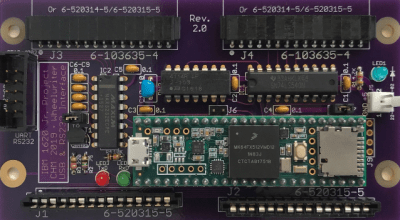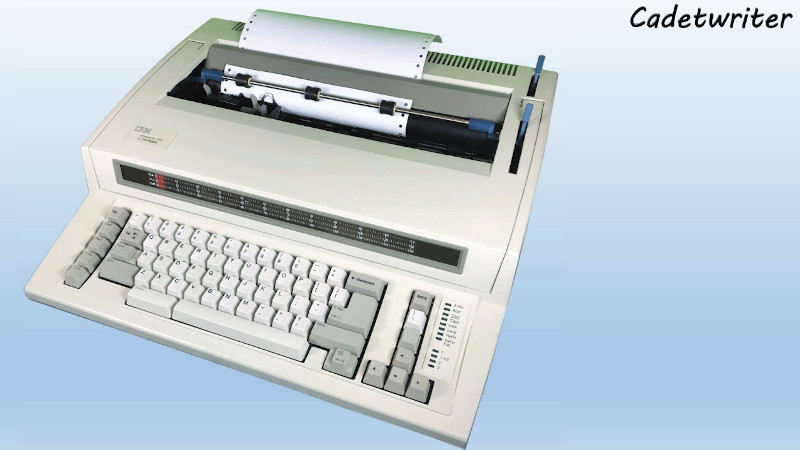It may come as little surprise to find that Hackaday does not often play host to typewriter projects. While these iconic machines have their own particular charm, they generally don’t allow for much in the way of hardware modification. But then the IBM Wheelwriter 1000 isn’t exactly a traditional typewriter, which made its recent conversion to a fully functional computer terminal possible.
 A product of the Computer History Museum’s [IBM 1620 Jr. Team], this modification takes the form of a serial interface board that can be built at home and installed into the Wheelwriter. The board allows the vintage electronic typewriter to speak RS-232 and USB, so it can be connected to whatever vintage (or not so vintage) computer you can imagine. The documentation for the project gives a rough cost of $150, though that does assume you’ve already got a Wheelwriter 1000 kicking around.
A product of the Computer History Museum’s [IBM 1620 Jr. Team], this modification takes the form of a serial interface board that can be built at home and installed into the Wheelwriter. The board allows the vintage electronic typewriter to speak RS-232 and USB, so it can be connected to whatever vintage (or not so vintage) computer you can imagine. The documentation for the project gives a rough cost of $150, though that does assume you’ve already got a Wheelwriter 1000 kicking around.
The GitHub repository includes everything you need to create your own board, and there’s even a highly detailed installation guide that goes over the case modifications necessary to get the new hardware installed. It also explains that you’ll want to get a new keycap set for your Wheelwriter if you perform this modification, as the original board doesn’t have all of the ASCII characters.
So why adapt an old electric typewriter to function as a teletype? As explained by the [IBM 1620 Jr. Team], there are projects out there looking to recreate authentic 1960s-era computing experiences that need a (relatively) affordable paper terminal. The originals are too rare to use in modern recreations, but with their adapter board, these slightly less archaic input devices can be used in their place.
Once you’ve built your new teletype, or in the somewhat unlikely event you already have one at the ready, we’ve seen a couple of projects that you might be interested in to put it to use.
















Needs wifi and a battery. It’s not a modern watchmajigger without wifi and a battery.
video presentation: http://youtu.be/f5bpK3Gou1Q
There was an interface board available from IBM when the Wheelwriter was originally sold.
Yes, but it was an output-only connection. You couldn’t use the typewriter as a terminal, only a printer.
Yes, but that was an output-only connection. It wouldn’t work as a terminal, only a printer.
Yes, we have one at the time in 1990-91, and used as a daisy printer only for testing few days, then we returned to the seller because prefered an Epson dot printer. The RS232 interface came integrated with the printer, as an extra.
Where’s the 555?
You’ll excuse we vintage people who start bleeding from the ears at the thought of such a thing returning from its cthonic rest to bedevil us.
I had an IBM Selectric typewriter that was converted. IIRC they dubbed it a Selecterm. I think it was a printer only.
correct
the kit was a bitch to fit!
it was one of those jobs where you had to set aside most of a day, needed a Polaroid camera to take a few photos
it voided Big Blues warranty and they would not repair any type writer after conversion
The 2741 was a legit IBM product. But the duty cycle was way more than the Selectric mechanism was designed for…so reliability wasn’t great.
Does it ring a bell when CTL-G is pushed?
No, they didn’t. I don’t think they talked ASCII either. Probably EBCDIC. We used them for APL (A Programming Language) terminals.
It beeps for ^G. Does that count?
Gotta pore over this for the “sometime” list. Was surprised at $150 cost estimate, but realised reading pdf they paid $10 for some SIL header strip so you can chip away at that, also IDK if you realllllly need the keycaps unless you want museum quality piece. Think I could scrape it together with only $30 out of pocket, but that’s relying on personal stash/stock and some graverobbing/salvage. Could think of re-implementing with an ESP 8266/32 then it’s got WiFi with terminal friendly AT command interface. Could improve on the install a tad by 3d print of plate/plug for the knockout, or neat metalwork.
Ought to actually check what actual IBM typewriter I’ve got hiding in one of the back piles. It’s officially my wife’s. Last time I looked at it was a decade back when there was something cool you could do with a particular selectric, but that wasn’t it.
Been looking at the ancient scrolls (Pre 1980 microcomputer journals) and getting the itch to screw around with replicas, when of course cheap surplus teletypes were the bread and butter of human computer interfaces. Who could afford to blow a whole couple hundred bucks (Nearer $1000 in 2019 money) just on the RAM to build a decent VDU?? Guess that was a first half of the 70s thing mostly, until RAM prices dropped a bit. Though still, thinking about the ordinary hackers, same type as the ones who aren’t browsing Hackaday on an i9 with dual 2080 GPUs just ‘coz it’s the best of “the day”.
You could absolutely implement this technique for significantly less, but I think a big part of the goal here was building something that could be effectively a drop-in upgrade, so there’s a certain expense involved there. I’m not sure what their plans are, but potentially a small commercial run of the adapters in the future wouldn’t be out of the question.
Wow! I could really annoy my coworkers with that!
I think…”Selecterm” was the name of the company that leased them. IBM called them something else..2741 comes to mind. They were a Selectric printer mechanism with a whole lot of switches and solenoids to make it a terminal.
Source: I used to service terminals at the computing center when I was in college. We had some 2741s leased from Selecterm. They came in two versions: Correspondence and something else. You had to match the typeball to the coding or you’d get garbage even though it was working perfectly.
Hey its my third third FD printer in its original form.! Later parts to go on to CNC. Nice work turning it into a slow ass terminal. Daisywheels and ink cartridges still around. Shoulda found one of the ol tractor feeds for it and 232 /485/488 and a IBM parallel (not centronics) interface cards were available for wheelwriter line. Would have saved some time but throwing away money already.
For the scavenger there are some real nice 24VDC steppers, have duty cog belt driven carriage, linear 32-45VDC power supply, and an easily modifiable PBL3717 motherboard stepper drivers on some.
The Wheelwriters are also basically Model M keyboards with a strange layout.
Shades of 1989 and my 1st “real” job. One of the systems I babysat was a Tandem NSII with a DECwriter terminal / log / console. It was obsolete even then, but banks earned the rep for being cheap.
Could an electric perkins brailler–one of the most durable long-lasting machines on the market–could it be hacked with a raspberry pie and used as a computer-driven semi-automated embosser along with the free braille blaster software? If anyone is willing to try this in order to make a low-cost embosser, just send me an email, I will spell out my email address so it gets posted here. J o s h k n n d 1 9 8 2 at-sign g m a i l dot c o m Thanks.
does it work on typewriters other than the wheel-writer series of typewriters
Conceptually the approach would work with any all-electronic typewriter where you could intercept the connection between the keyboard and the typewriter’s motherboard.
However, the Serial Interface Board that our team designed is very specific to the Wheelwriter’s electronics and probably wouldn’t work in a different brand of typewriter. Also, our firmware is VERY specific to the operation and timing of the Wheelwriter and would need to be rewritten.
One thing to note is that in the 18 months since this Hackaday article was written, there have been several significant enhancements and changes made to the firmware to support other model Wheelwriter typewriters. To date, 5 different models of Wheelwriters have been successfully adapted with different keyboards, wide carriages, 2-part motherboards, and faster print mechanisms. A small set of compile-time define specific variations of the different models to make adapting other Wheelwriters simple.
thank you:) the reason i asked is because i have a smith corona se 100